Developing impeccable timing is crucial for any guitarist, whether you’re a beginner strumming your first chords or a seasoned pro shredding solos. The cornerstone of rhythmic precision? The Guitar Metronome. This essential tool isn’t just a click track; it’s your personal rhythm coach, helping you internalize tempo, master complex time signatures, and ultimately become a moreGroße musician. Let’s dive into why a guitar metronome is indispensable for your practice routine and how to make the most of it.
Why Every Guitarist Needs a Metronome
At its heart, a metronome is a device that produces a consistent, audible pulse at a set tempo. This pulse, measured in BPM (beats per minute), provides a rhythmic framework for your practice. While traditional metronomes were mechanical, modern guitarists often turn to electronic or online guitar metronomes for their convenience and versatility.
The benefits of incorporating a guitar metronome into your practice are numerous:
- Improved Timing and Rhythm: The most obvious benefit is developing a strong sense of timing. A metronome keeps you honest, highlighting any rushing or dragging in your playing.
- Consistent Tempo: Whether you’re learning a new riff or practicing scales, a metronome ensures you maintain a consistent tempo throughout, building muscle memory and preventing bad habits.
- Increased Speed and Accuracy: By gradually increasing the tempo on your guitar metronome, you can incrementally improve your playing speed without sacrificing accuracy.
- Mastering Different Time Signatures: Beyond simple 4/4 time, exploring different time signatures is essential for musical growth. A guitar metronome allows you to practice in 3/4, 6/8, and even complex time signatures, expanding your rhythmic vocabulary.
- Enhanced Groove and Feel: Practicing with a metronome isn’t just about technical accuracy; it’s about developing a solid groove and feel in your playing, making your music more engaging and dynamic.
Understanding Tempo: BPM and Tempo Markings
BPM (Beats Per Minute) is the standard unit for measuring tempo. A setting of 60 BPM means there are 60 beats in one minute, or one beat per second. Many guitar metronomes default to 120 BPM, a moderate tempo suitable for various musical styles.
Classical music often uses Italian tempo markings to indicate the desired pace. While BPM provides a precise measurement, these markings offer a more descriptive and nuanced understanding of tempo:
- Larghissimo: Very, very slow (up to 20 BPM)
- Grave: Slow and solemn (21-40 BPM)
- Lento: Slow (41-45 BPM)
- Largo: Broad and slow (46-50 BPM)
- Adagio: Slow and stately (51-60 BPM)
- Adagietto: Rather slow (61-70 BPM)
- Andante: Walking pace (71-85 BPM)
- Moderato: Moderate tempo (86-97 BPM)
- Allegretto: Moderately fast (98-109 BPM)
- Allegro: Fast and lively (110-132 BPM)
- Vivace: Very fast and lively (133-140 BPM)
- Presto: Extremely fast (141-177 BPM)
- Prestissimo: As fast as possible (178-240 BPM)
Understanding these markings can add depth to your musical interpretation and practice. Your guitar metronome is a tool to explore these tempos and develop your internal sense of pace.
Exploring Time Signatures with Your Guitar Metronome
Beyond tempo, time signatures are fundamental to rhythm. They dictate how beats are grouped into measures and influence the feel of the music. A time signature is written as a fraction, with the top number indicating beats per measure and the bottom number specifying the note value that receives one beat.
- 4/4 Time (Common Time): Four beats per measure, quarter note gets one beat. Extremely common in popular music.
- 3/4 Time (Waltz Time): Three beats per measure, quarter note gets one beat. Creates a waltz-like feel.
- 6/8 Time: Six beats per measure, eighth note gets one beat. Often felt in two groups of three, creating a compound meter.
More complex time signatures exist, adding rhythmic interest and challenge:
- 5/4, 7/8, 9/8, 10/8, 11/8, 12/8, 13/8: These signatures offer unique rhythmic possibilities and are found in genres like progressive rock, jazz, and world music.
Experimenting with different time signatures on your guitar metronome expands your rhythmic horizons and prepares you for a wider range of musical styles. Features like accent control, available on advanced guitar metronomes like the GuitarApp metronome, allow you to emphasize the first beat of each measure, making it easier to navigate different time signatures. Tap tempo is another useful feature, enabling you to quickly set the tempo by tapping along to the desired beat.
Level Up Your Guitar Practice with a Metronome
A guitar metronome is more than just a practice tool; it’s an investment in your musicality. By consistently practicing with a metronome, you’ll develop rock-solid timing, rhythmic precision, and a deeper understanding of musical time. Whether you choose a traditional mechanical metronome, a digital device, or a convenient online guitar metronome, make it a regular part of your guitar journey and unlock your full rhythmic potential.

